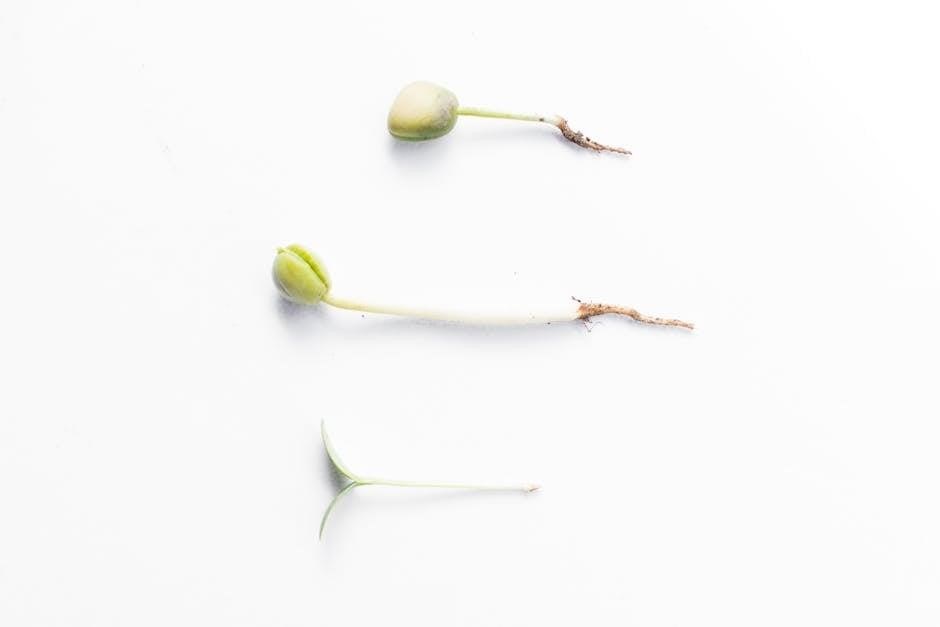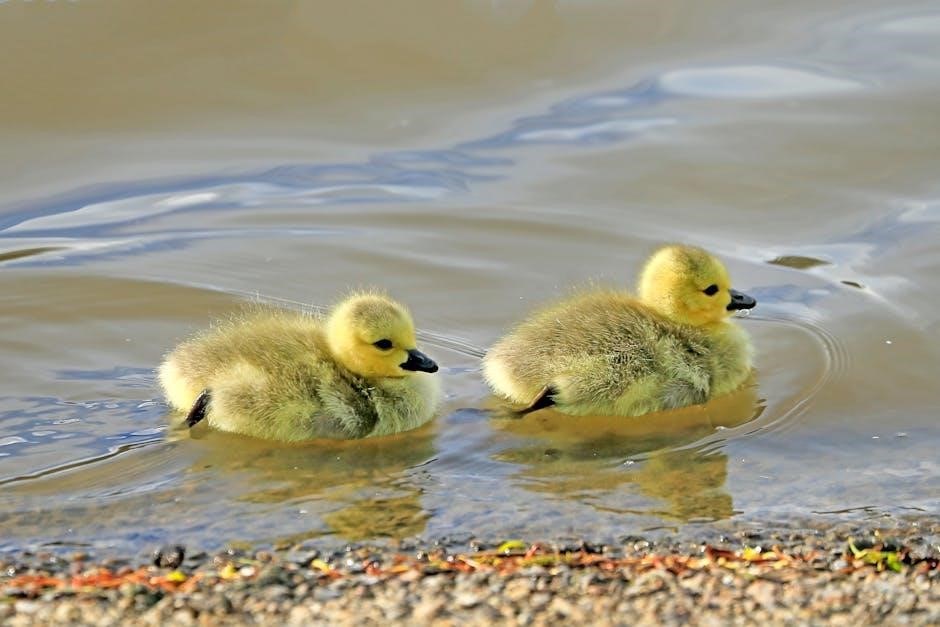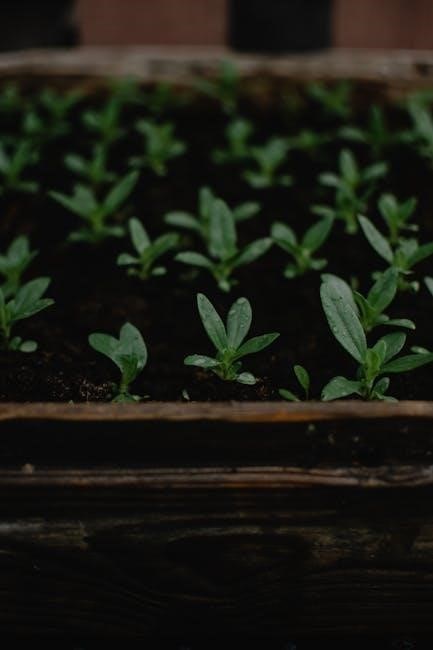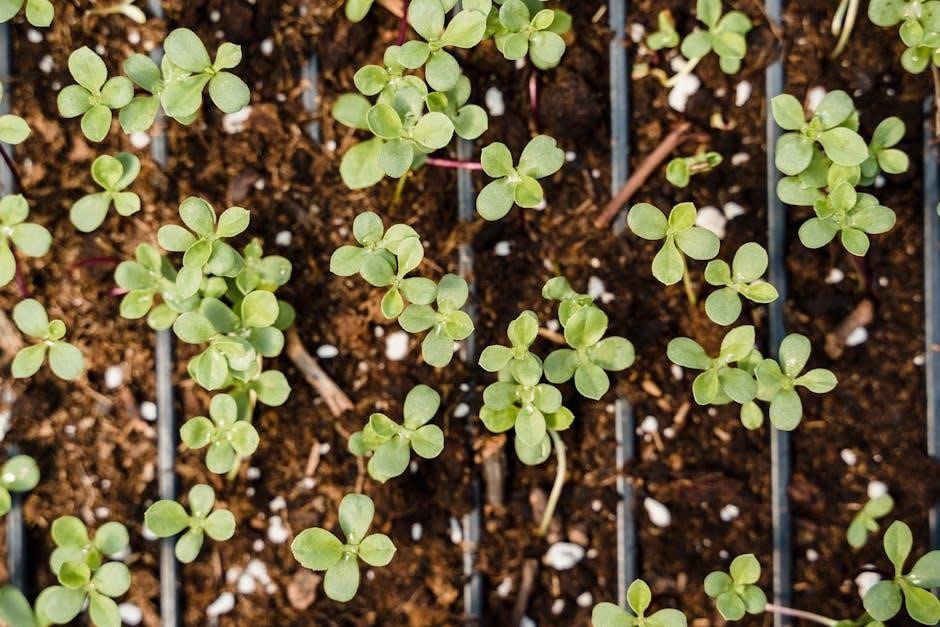The West Coast offers a unique gardening climate with mild winters‚ cool summers‚ and distinct growing seasons. Understanding regional conditions is key to successful gardening in this area.
Understanding the Unique Conditions of the West Coast
The West Coast’s maritime climate features mild‚ wet winters and cool‚ dry summers‚ creating a unique growing environment. Frost dates are minimal in many areas‚ allowing year-round planting in zones like 8a and 9b. The region’s rainfall patterns and narrow temperature fluctuations support a wide variety of crops‚ but require careful planning to adapt to seasonal changes and microclimates.
Importance of Seasonal Planting on the West Coast
Seasonal planting is crucial on the West Coast due to its mild winters and cool summers. Aligning plantings with seasonal patterns ensures optimal growth and reduces challenges like frost or pests. Early spring is ideal for cool-season crops‚ while late summer prepares for fall harvests. This approach maximizes growing conditions‚ supports soil health‚ and enhances water efficiency‚ making it a cornerstone of successful West Coast gardening practices.

Best Seeds for West Coast Gardens
Choose seeds adapted to the West Coast’s mild climate‚ such as leafy greens‚ tomatoes‚ carrots‚ and herbs like basil. Flowers like sunflowers and marigolds also thrive here.
Popular Vegetables for West Coast Climate Zones
The West Coast’s mild climate supports a wide variety of vegetables. Leafy greens like spinach and kale thrive in cooler seasons‚ while tomatoes‚ peppers‚ and cucumbers excel in warmer months. Root vegetables such as carrots‚ radishes‚ and beets grow well year-round. Broccoli‚ Brussels sprouts‚ and peas are also ideal for the region’s conditions‚ making it a versatile area for diverse gardening interests.
Herbs and Flowers Ideal for West Coast Gardens
West Coast gardens thrive with herbs like basil‚ rosemary‚ and thyme‚ which love the mild climate. Flowers such as marigolds‚ sunflowers‚ and calendula attract pollinators and add vibrancy. These plants are perfect for seasonal planting‚ enhancing biodiversity and soil health. Plant herbs in spring for summer harvests‚ while flowers bloom beautifully in early summer‚ creating a balanced and thriving garden ecosystem.

West Coast Seed Planting Calendar
Plan your garden with a seasonal planting calendar tailored to the West Coast climate‚ ensuring optimal growth and harvests throughout spring‚ summer‚ fall‚ and winter.
Spring Planting Guide
Spring is ideal for planting cool-season crops like spinach‚ lettuce‚ and peas. Start seeds indoors 4-6 weeks before the last frost date for tomatoes and peppers. Direct sow carrots‚ radishes‚ and beets as soon as soil can be worked. Incorporate flowers like marigolds and calendulas to attract pollinators. Stagger planting every 1-2 weeks for a continuous harvest. Use regional planting charts to optimize timing and maximize yields.
Summer‚ Fall‚ and Winter Planting Options
On the West Coast‚ summer planting focuses on warm-season crops like tomatoes and beans. Fall and winter offer opportunities for cool-season crops such as broccoli‚ kale‚ and spinach. Using a planting chart specific to your region ensures optimal timing for seeds like carrots and radishes. These seasons also allow for planting flowers like violas and pansies‚ enhancing garden diversity and beauty year-round.

Companion Planting on the West Coast
Companion planting enhances growth by pairing vegetables‚ herbs‚ and flowers that naturally deter pests. Use charts to guide beneficial pairings‚ like tomatoes with basil or marigolds with vegetables.
Benefits of Companion Planting
Companion planting enhances garden health by deterring pests‚ improving growth‚ and maximizing space. Certain plants release chemicals that repel insects‚ while others attract pollinators. This method also promotes soil fertility and reduces competition for nutrients. On the West Coast‚ specific plant combinations thrive in the mild climate and moist soil‚ creating a balanced and productive ecosystem for sustainable gardening practices.
West Coast-Specific Companion Planting Chart
A West Coast-specific companion planting chart helps gardeners maximize growth and deter pests. It outlines which plants thrive together‚ such as tomatoes with basil or marigolds. Regional favorites like kale and carrots benefit from pairing with onions or radishes. The chart also highlights plants that repel pests‚ like nasturtiums for aphids. This guide ensures harmony in your garden‚ fostering healthy growth and biodiversity.

Soil Preparation for West Coast Gardens
Testing and amending soil is crucial for optimal plant growth. Incorporating organic matter improves drainage‚ fertility‚ and overall soil health‚ ensuring robust root development and nutrient retention.
Testing and Amending Soil
Testing soil is crucial to determine pH levels and nutrient content. West Coast gardens often benefit from adding organic matter like compost or manure to improve soil structure and fertility. Based on test results‚ amend soil with lime to raise pH or sulfur to lower it. Proper soil preparation ensures optimal growth for seeds and plants in the region’s unique climate conditions.
Role of Organic Matter in Soil Health
Organic matter is the foundation of healthy soil‚ enhancing structure‚ water retention‚ and nutrient availability. It feeds beneficial microbes‚ fostering a vibrant ecosystem. Compost and manure enrich the soil‚ improving fertility and root growth. Regularly incorporating organic matter ensures sustained plant health and resilience‚ especially in the West Coast’s diverse climate zones. This practice promotes sustainable gardening and maximizes harvest potential.
Garden Planning and Design
Effective garden planning involves mapping layouts‚ selecting suitable plants‚ and preparing beds to maximize space and growth potential‚ ensuring a thriving West Coast garden.
Layout and Bed Preparation
Proper layout and bed preparation are crucial for maximizing space and ensuring healthy plant growth. Assess your garden’s microclimate‚ considering sunlight and drainage. Use raised beds for better soil drainage and accessibility. Plan the layout to allow adequate spacing between plants‚ promoting air circulation. Create a detailed map of your garden beds to visualize plant placement. Incorporate pathways for easy access. Amend soil based on the specific needs of your plants‚ ensuring a fertile foundation for growth.
Importance of Crop Rotation
Crop rotation is essential for maintaining soil health and maximizing yields. It prevents nutrient depletion‚ reduces pest and disease buildup‚ and improves soil structure. By rotating crops‚ gardeners can ensure balanced nutrient availability‚ promote biodiversity‚ and create a resilient ecosystem. This practice is particularly beneficial in the West Coast’s diverse climate zones‚ where soil health is crucial for sustainable gardening success.

Seed Starting Basics
Start seeds indoors 4-6 weeks before the last frost date. Transplant seedlings after hardening off. Use a planting chart to time sowings for optimal growth and harvest.
When to Start Seeds Indoors
On the West Coast‚ seeds for cool-season crops like broccoli and kale can be started indoors 4-6 weeks before the last frost date. Tomatoes and peppers require 6-8 weeks. Check regional planting charts for specific timing‚ as mild winters allow for year-round gardening in some areas. Start seeds in a sunny spot or under grow lights‚ ensuring soil stays warm for optimal germination.
Transplanting Seedlings Outdoors
Transplanting seedlings outdoors requires careful preparation. Harden off seedlings over 7-10 days to acclimate them to outdoor conditions. Choose overcast days or early morning for transplanting to minimize stress. Ensure seedlings have sturdy stems and dark green leaves before moving them. Plant at the same depth as indoors‚ water thoroughly‚ and monitor for signs of shock. Follow regional planting charts for optimal timing.

Common Challenges on the West Coast
Pests like aphids and mites‚ diseases such as powdery mildew‚ and unpredictable weather patterns pose significant challenges for West Coast gardeners‚ requiring adaptive strategies and careful planning.
Pests and Diseases Specific to the Region
The West Coast faces pests like aphids‚ slugs‚ and snails‚ while diseases such as powdery mildew and root rot thrive in its cool‚ moist climate. Regular monitoring and organic control methods‚ like neem oil and crop rotation‚ are essential to maintain healthy plants and prevent infestations.
- Aphids target young shoots and leaves.
- Slugs and snails damage plants at night.
- Powdery mildew affects foliage in humid conditions.
Weather-Related Challenges and Solutions
West Coast gardeners face challenges like excessive rain‚ cool temperatures‚ and fog‚ which can hinder seed germination and plant growth. Solutions include using cold frames‚ greenhouses‚ or raised beds to improve drainage and warmth. Planting weather-resistant varieties and adhering to regional planting charts also helps optimize growing conditions and ensure successful harvests.
Using the West Coast Seeds Planting Chart
The chart provides a structured guide for optimal planting times‚ ensuring gardeners align with seasonal cycles and regional conditions for maximum yield and sustainability.
How to Read and Apply the Chart
The West Coast Seeds planting chart is organized by plant type‚ season‚ and climate zone. Start by identifying your specific zone to determine optimal planting times. Look for symbols or notes indicating when to sow seeds directly or start indoors. Use the chart to plan spacing and timing for continuous harvests. Reference it regularly to ensure your garden thrives throughout the growing season.
Customizing the Chart for Your Garden
Adapt the West Coast planting chart to your specific garden by considering microclimates‚ soil type‚ and weather patterns. Adjust sowing dates based on local conditions and observe seasonal shifts. Use the chart as a flexible guide‚ tailoring it to your garden’s unique needs for optimal growth and harvest success.
Sustainable Gardening Practices
Adopt eco-friendly methods like seed saving and composting to reduce waste and promote biodiversity. These practices enhance soil health and support long-term garden sustainability.

Companion planting and crop rotation are key strategies to naturally deter pests and enrich soil‚ ensuring a balanced and thriving West Coast garden ecosystem.
Seed Saving and Reusing Seeds
Seed saving is a sustainable practice that preserves genetic diversity and reduces costs. Allow seeds to mature fully before harvesting. Dry thoroughly to prevent mold. Store in airtight containers in a cool‚ dark place. Reusing seeds ensures adaptability to your garden’s climate. Resources like the Edible Garden Project offer guidance for successful seed saving and reusing in West Coast gardens.
Eco-Friendly Gardening Tips
Adopt sustainable practices like seed saving and composting to reduce waste. Use organic matter to enrich soil and promote healthy plant growth. Incorporate companion planting to naturally deter pests‚ reducing the need for chemicals. Choose drought-resistant plants to conserve water‚ especially in dry West Coast summers. These eco-friendly methods support biodiversity and create a thriving‚ environmentally conscious garden.
West Coast gardening thrives with the right seeds and timing. For more guidance‚ explore the West Coast Seeds Catalogue‚ local nursery workshops‚ and online gardening forums.
- West Coast Seeds Catalogue: Detailed planting charts and seed varieties.
- Local Nursery Workshops: Hands-on learning and expert advice.
- Online Gardening Forums: Community tips and troubleshooting.
Final Tips for Successful West Coast Gardening
Follow the West Coast Seeds Gardening Guide for region-specific advice. Understand your climate zone and soil type to optimize growth. Sow seeds at intervals for continuous harvests. Use the vegetable planting chart to plan seasons effectively. Save seeds for future use and adopt eco-friendly practices. Regularly monitor for pests and diseases‚ and maintain soil health for a thriving garden.
Recommended Guides and Tools
For successful West Coast gardening‚ utilize the West Coast Seeds Gardening Guide‚ which offers detailed planting charts and seasonal advice. The Vegetable Planting Chart provides specific timing for optimal harvests. Additional resources like the Edible Garden Project and Companion Planting Chart enhance sustainability and crop health. These tools are essential for maximizing yields and maintaining a thriving garden.

